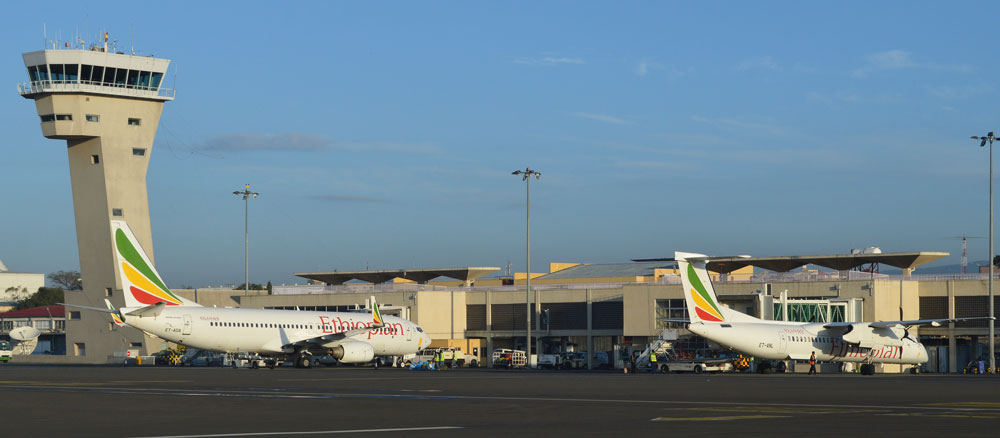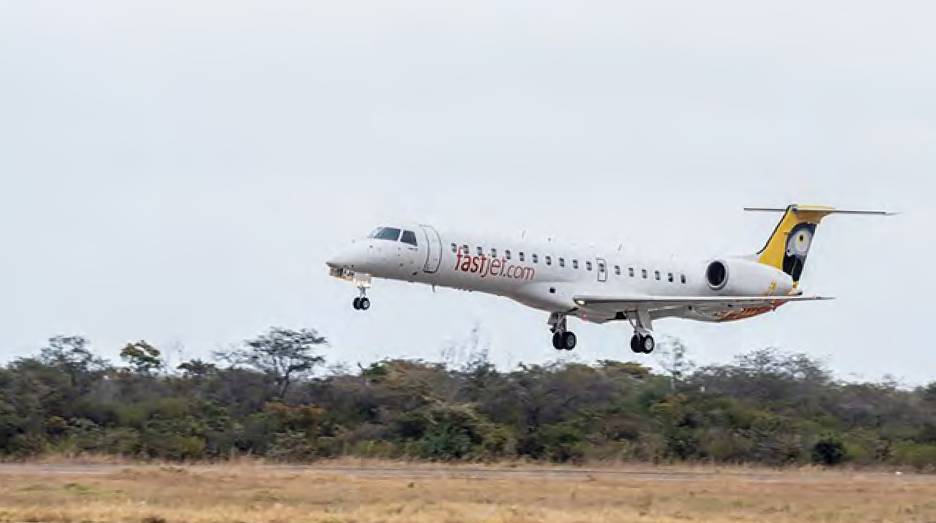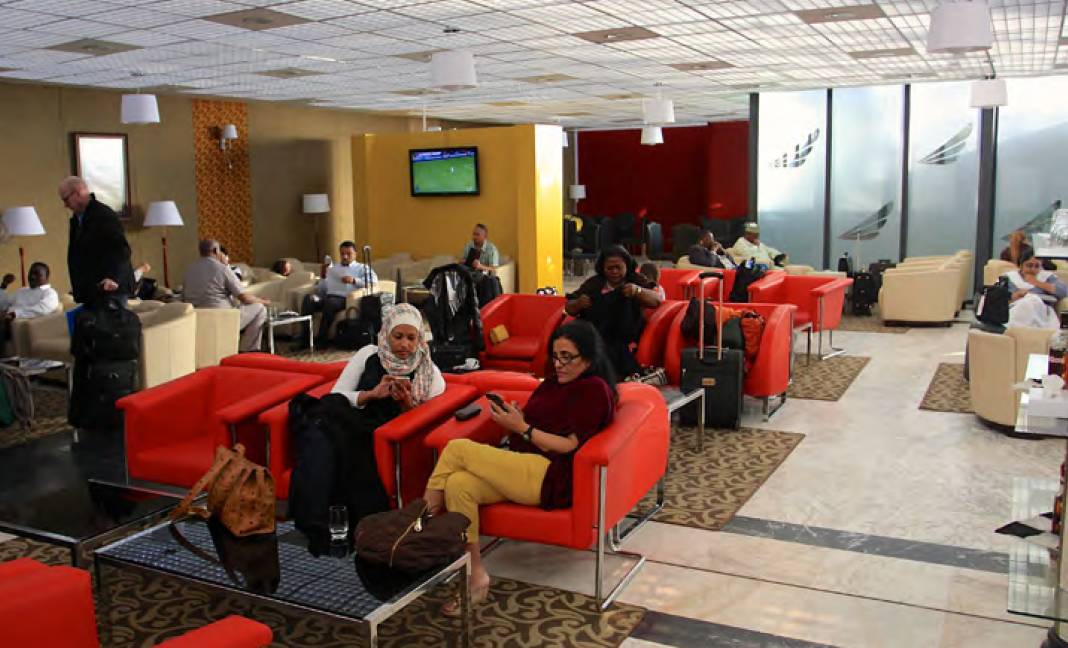AIR TRANSPORT African airlines
Getting Africa on the move
For years, African commercial aviation has suffered from a combination of protectionism, high taxes and low levels of connectivity – especially in intracontinental flights. Will the arrival of the Single African Air Transport Market finally improve matters? ALAN DRON reports.
 Two of the continent’s most successful airline’s fleet, those of Ethiopian Airlines, on stand at their home airport, Bole International Airport, Addis Ababa, Ethiopia. Alan Wilson
Two of the continent’s most successful airline’s fleet, those of Ethiopian Airlines, on stand at their home airport, Bole International Airport, Addis Ababa, Ethiopia. Alan Wilson
It has been a long, hard journey but it appears that Africa may finally be on the verge of getting the air transport system it needs and deserves. The Single African Air Transport Market (SAATM), a form of Open Skies agreement, seeks to bring the same ease of travel that has been enjoyed in Europe for the past 25 years to the African continent. The outlook is hopeful but some countries still have reservations.
SAATM is a flagship project of the African Union Agenda 2063, an initiative to create a unified market in Africa to advance the liberalisation of civil aviation and act as an impetus to the continent’s economic integration agenda.
But why has it taken so long to get to this stage? By most criteria, Africa should have a thriving commercial aviation sector. With a population of more than 1bn, 54 nations, long distances to cover between points on the continent and a growing middle class, for many years commentators have predicted that the continent is about to ‘take off’ in aviation terms. Yet it has not happened.
Connecting the continent
For too long, the continent’s air links have been shackled by a combination of factors, including national protectionism, high ticket and fuel prices, excessive airport charges and difficulty in obtaining visas for intra-African travel.
AT THE TIME OF WRITING, AROUND 34% OF AFRICA’S 1.1BN INHABITANTS COULD BE CLASSIFIED AS MIDDLE CLASS
A 2017 book, Fly Africa, by aviation industry insiders Hassan El-Houry and Eric Kacou, noted that the continent had 731 airports and 419 airlines but very few successful ones. Even today, ElHoury noted, Africans make up 12% of the world’s population but only 5% of its airline passengers.
Widespread poverty on the continent has, of course, been a major hindrance in aircraft becoming the everyday mode of transport that they are in North America, Europe, Asia-Pacific and, increasingly, the Middle East. However, Africa is becoming richer. The authors calculated that, at the time of writing, around 34% of Africa’s 1.1bn inhabitants could be classified as middle class.
Since then, improvements have continued, El-Houry, CEO of Kuwait’s National Aviation Services, a major supplier of services, including ground-handling, training and security, told AEROSPACE. The global pandemic had obviously had a dampening effect on progress but Africa had remained resilient.
 Sharm El-Sheikh International Airport, Egypt. arch2452
Sharm El-Sheikh International Airport, Egypt. arch2452
High-cost flying
“One major factor behind the continent’s lagging performance has been the low adoption rate of lowcost travel,” he said. Europe and the US have seen carriers, such as Ryanair, easyJet and Southwest, hugely increase the number of flyers – both people who have taken to the skies for the first time and existing passengers who now fly more frequently. “We believe that, if we were to increase low-cost travel [in Africa], it would be more accessible to everyone and you would have a more inclusive aviation sector,” El-Houry said.
Which brings us to one of the major factors that has held back aviation in Africa – high prices. Many African governments have taken the view that, if someone is rich enough to be an airline passenger, they are rich enough to be taxed heavily. So, airport charges and taxes on tickets are high.
It is not unusual, for example, for departure taxes from African airports to reach $100. That pushes up the price of tickets and takes them out of the reach of many. Those people who can afford them typically pay much more when flying within Africa than passengers travelling in other continents.
El-Houry and his co-author Kacou, the CEO of Cote d’Ivoire-based advisory and investment company Entrepreneurial Solutions Partners, calculated, for example, that “one dollar spent in economy class in Africa enables passengers to travel 6.04km. The same dollar spent in Europe propels passengers an average of 44.44km.” The unconnected problem On top of that, the problem of connectivity has long bedevilled air services in Africa. Many countries still do not provide visas on arrival. Moreover, as many African nations do not have embassies or consulates in every country on the continent, this often means that a passenger wanting to travel from country A to country B initially has to travel to country C, simply to get a visa from country B’s nearest diplomatic mission.
This makes it considerably more difficult to fly where you want, when you want. A further connectivity problem is that African airports serve far fewer destinations than their counterparts in Asia-Pacific, North America or Europe. This has led to the longstanding and somewhat ridiculous situation of passengers often having to connect between two African cities via distant European or Middle Eastern hubs.
Consultant Tilmann Gabriel, who is heavily involved in African aviation, primarily as advisor to Nigeria’s aviation minister, Senator Hadi Sirika FRAeS, gives a notable example: “If you have to fly from Lagos or Abuja to Dakar, you have to fly via London.” What should be a two to three-hour flight between two West African cities becomes a 12-hour one – and that is without factoring in the connection time at Heathrow.
Similarly, Paris is a connecting hub for many francophone African nations and, in recent years, the mega-hubs in Dubai, Doha and Istanbul have also started to draw in connecting African traffic.
The problem of non-African airlines siphoning off traffic that African flag carriers should be carrying has become noticeably worse over the past decade, as Emirates, Etihad, Qatar Airways and Turkish Airlines have increasingly pushed into Africa, deploying their rapidly-growing fleets to funnel African passengers through their hubs and on to their final destinations. Indeed, Turkish is on record as saying that its ambition is to become Africa’s largest carrier.
The trailblazing Ethiopian Airlines
Few African carriers have the strength to compete with these giants. The exception is Ethiopian Airlines, whose management, together with the country’s government, have shown consistency, commitment and foresight in promoting aviation in their country. Critically, the Ethiopian government has resisted the temptation to interfere in the airline’s affairs but supports it by providing essential infrastructure – for example, in the form of a new, $3bn airport in Addis Ababa that will have an eventual capacity of 70m passengers annually.
 Addis Ababa airport. Bradley Howard
Addis Ababa airport. Bradley Howard
Other factors in Ethiopian’s favour are good relationships between management and workers, a more balanced route network (which earns just one-third of its revenue from Africa, yet has a 15-point domestic route network) and strong relationships with other African nations, including investments in other carriers.
Ethiopian retains further ambitions within the continent and is keen to get involved in Nigeria, said Gabriel. Apart from Ethiopian, Kacou and El-Houry noted in Fly Africa that Royal Air Maroc, RwandAir and Air Cote d’Ivoire showed real potential and El-Houry told AEROSPACE that more companies are now following Ethiopian’s model.
However, they predicted in 2017 that three better-known names – Egyptair, Kenya Airways and South African Airways – faced a more uncertain future.
Two of those predictions have come to pass, with South African Airways only now emerging from an 18-month ‘business rescue’ (roughly similar to administration) with a much-reduced fleet and Kenya Airways in the process of being renationalised after making heavy losses.
Highly variable infrastructure standards in Africa have also been a factor in the slow pace of commercial aviation development. This can be demonstrated in a single statistic: around one-third of all Africa’s international traffic passes through just three hubs – Addis Ababa, Johannesburg and Nairobi, home to Ethiopian Airlines, Kenya Airways and South African Airways respectively.
Getting Africa airborne
With all these problems in mind, there have been long-running attempts to improve commercial aviation in Africa.
The World Bank noted a decade ago that many newly-independent African states created national airlines in the early 1960s, partly to assert their new status as nations. Most were given political ‘cover’ in the form of measures to protect them from international competition.
 FastJet is a low-cost African airline operating out of Zimbabwe. FastJet
FastJet is a low-cost African airline operating out of Zimbabwe. FastJet
By the late 1980s, however, states were starting to realise the error of their ways, with the strict regulatory protection that sustained those carriers leading to inflated airfares and dampened traffic growth.
In the 1988 Yamoussoukro Declaration many African countries agreed to principles of air services liberalisation. It took another 11 years for the similarly named Yamoussoukro Decision to follow up on this, by committing its 44 signatory countries to deregulate air services and promote regional air markets open to transnational competition.
The 1999 Decision was endorsed by head of states at the Organization of African Unity the following year and became fully binding in 2002.
Since then, however, innumerable conferences on African aviation have heard warm words of support for air transport liberalisation from African ministers and officials but have seen little in the way of actions to make it a reality.
The latest effort to revitalise the process, SAATM, was agreed in 2018. Finally, movement appeared on the horizon and 34 states have now signed up to it.
The International Air Transport Association (IATA), the airlines’ representative body, is strongly in favour of the initiative. “I think the SAATM concept is what Africa – and the world – needs,” said IATA regional vice-president, Africa and Middle East, Kamil Al-Awadhi. “It’s a really good concept. All the relevant stakeholders are actively engaged.”
However, he added, his experience was that airlines could move far faster than governments or finance ministries and he wanted to see the latter speeding up their actions. Additionally, not all governments were yet fully on board with SAATM: “I sense there’s a bit of scepticism from some of the states but it’s a minority.”
El-Houry concurs with that appraisal: “I don’t believe that dealing with any government agency, whether in Africa or anywhere in the world, is like flicking a light switch; it’s not off/on. There are 54 countries, each with their own policy objectives and their own stakeholders. It’s extremely complex. But I think [SAATM] is a step in the right direction. We have a lot of momentum to get more countries signed up.” Increasing political stability in many parts of the continent also provides better conditions in which aviation can prosper, he says.
Gabriel sounds some notes of caution: many countries are still hesitant to open up their skies to SAATM for fear that increased competition will damage their national carriers. Many western and southern African airlines still want to fly to Europe, rather than to closer regions, such as North Africa, and there are still too few airports that meet international standards.
Brighter future African skies
El-Houry believes that better times are coming for African aviation: “I was optimistic when I wrote the book and still am,” he says. Taxes remain a major issue. However, he believes governments are starting to see that taxes on aviation are not a tax on the wealthy but on a pillar of the country’s economy.
 Qatar Airways inaugurated its Abidjan-Doha route in June 2021. Qatar Airways
Qatar Airways inaugurated its Abidjan-Doha route in June 2021. Qatar Airways
“Aviation is a reflection of the overall economic prosperity of the region. Travel is definitely not the number one priority of people who are struggling to make ends meet but people are experiencing better economic prosperity. After China, the next big migration from lower class to middle class will be in Africa. Hundreds of millions of people will be urbanised over the next ten years.”
That view is echoed by IATA’s Al-Awadhi, who says that persuading governments of the benefits of keeping taxes on aviation low is possible but difficult. “If you walk [a government] through the benefits of increasing passengers and reducing taxes, you can get them to buy in,” he said.
“The two issues are trying to secure the meetings with the right stakeholders which is harder than you think; and just as you’re halfway through [the process] governments change and you’re starting from scratch again.”
While El-Houry believes that several of the surrounding factors may improve, African airlines must improve their performance in order to attract more passengers and become profitable. “There may be a direct flight [between two African cities] but a lot of the African carriers unfortunately aren’t very reliable. They may cancel flights or delay them for 12 hours.”
African airlines’ positions are sadly not helped by frequent changes of government. The chairman of an airline may fall out of favour with the relevant minister. However, El-Houry remains hopeful: “Let’s recreate in Africa what Europe successfully created: one policy to regularise conditions across the continent.”
 Two of the continent’s most successful airline’s fleet, those of Ethiopian Airlines, on stand at their home airport, Bole International Airport, Addis Ababa, Ethiopia. Alan Wilson
Two of the continent’s most successful airline’s fleet, those of Ethiopian Airlines, on stand at their home airport, Bole International Airport, Addis Ababa, Ethiopia. Alan Wilson Sharm El-Sheikh International Airport, Egypt. arch2452
Sharm El-Sheikh International Airport, Egypt. arch2452

